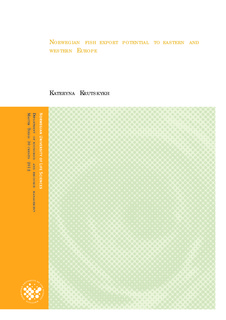| dc.description.abstract | The thesis attempts to estimate Norwegian trade potential in fish exports by using the augmented gravity models and panel data of five eastern and five western European countries. As an estimation technique for the period 1993-2010 fixed and random effects models have been used. The estimation results for four regressions are presented, namely: the regression on aggregated fish exports (salmon, trout, herring), and on salmon, trout and herring separately. The ratio between estimated potential trade and actual trade is then taken to predict Norwegian trade potential with the ten importing countries chosen for the analysis. The estimation results for aggregated fish exports suggest that Norwegian fish exports are positively affected by fish production in Norway, exchange rate, price, openness variable, an index of economic freedom (EFI) and common border dummy variable. In general the variables have the expected sign. However, the distance variable is highly statistically significant, but has an unexpected positive sign. Norwegian fish exports are negatively affected by importer’s GDP per capita. The importer’s country becomes more self-supported when GDP per capita increases, meaning that domestic production increases, which reduces the demand for imports. Norwegian exports of salmon are positively affected by importer’s GDP per capita, exchange rate and price, openness index (trade-GDP ratio), economic freedom index. The distance variable as well as the fish production variable has a negative effect on exports of salmon. However, common border dummy variable is not statistically significant and with an unexpected sign. The estimation results on exports of trout suggest that Norway’s trade in trout is positively affected by higher importer’s GDP per capita, exchange rate, price, openness variable, index of economic freedom. The common border dummy variable suggests that higher trade flows are attributed to the country that shares a common border with Norway. Norway’s trade in herring is positively affected by price, openness index and presence of common border. However, the importer’s GDP per capita has a negative effect on Norwegian exports of herring. The estimated results show that Norway has exploited and unexploited trade potential with some countries in the sample. Suggesting that results are important for trade policy formulation to enhance Norwegian fish exports. As one of the recommendations, Norwegian authorities are advised to conduct marketing promotion program in the countries where Norway has an unexploited export potential. | no_NO |
